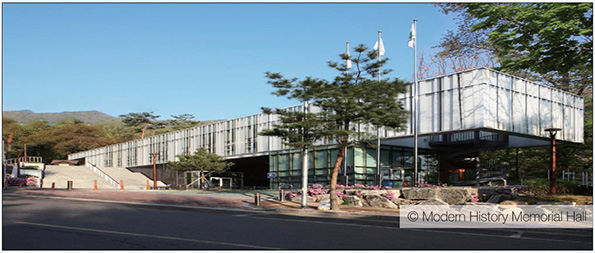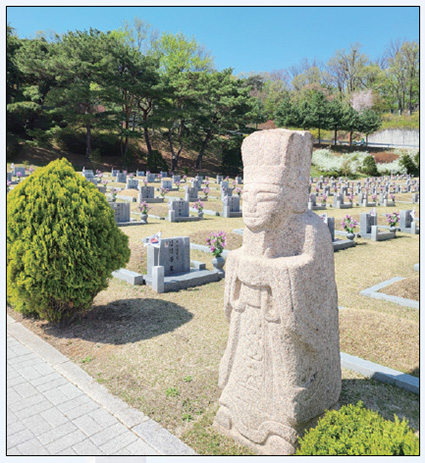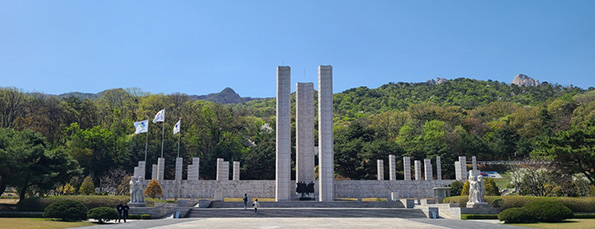
Near Buk-han Mountain in Seoul, there is a “Modern History Memorial Hall,” where people can sense the footsteps of their ancestors to protect the country’s freedom from the ruling class and foreign influences, and the April 19th National Cemetery, where the victims of the April 19 Revolution are buried. These heroes paid the ultimate price to protect the Korean democracy from the dictatorship of the “Lee Seung-man regime.” A CBT reporter visited the Modern History Memorial Hall and the April 19th National Cemetery in Seoul, to see records and exhibitions of an historical event in the past. Through this article, let’s explore the valiant efforts of our ancestors to protect the Republic of Korea.
Modern History Memorial Hall
On April 8, the CBT reporter traveled by KTX from Osong to Seoul Station at 08:53 a.m. and took the subway to the April 19th National Cemetery Station at around 10:30 a.m. After walking 20 minutes from Exit 2 of the station, statues of the faces of independence activists could be observed before entering the Modern History Memorial Hall.
In Suyu-ri, Gangbuk-gu, there are a total of 15 graves of independence activists(it was 16, but one grave was relocated to the National Cemetery on Aug. 15, 2022), and the Modern History Memorial Hall was opened in 2016 to commemorate their achievements and intentions. On the first floor, the memorial hall consists of an information center and a permanent exhibition hall, while on the second floor, people can check out a special exhibition hall, a lecture room, and an office. The Opening hours are 9:00 a.m. to 6:00 p.m.(visitors should enter 30 minutes before the deadline), and it is closed every Monday, Jan. 1, Lunar New Year and Chuseok holidays. The website of the Modern History Memorial Hall provides a “VR exhibition” where people can enjoy permanent and special exhibitions online, and can check announcements on events and education held by the memorial hall.

Permanent Exhibition
The permanent exhibition hall consists of three parts. ▲Zone A: Country has been Trampled, but People Stand Up, ▲Zone B: End of the Period and Greeting of Democracy, ▲Zone C: The Country where we live in, the Democratic Republic. Zone A displays descriptions and related exhibitions of historical events from the late 19th century to the Japanese colonial era. Next, Zone B shows a video of a man delivering “An ode to Korea’s democracy” to his father who passed away during the Korean War. Third, Zone C summarizes the events from the Japanese colonial era to April 19 Revolution.
While watching the exhibition, the CBT reporter was most impressed by the records of the “Provisional Government of the Republic of Korea.” There was a touchscreen, which provide photos and information about the activists who were members of the Provisional Government at the time, so visitors can check the less well-known activists. It was useful to learn specific details of Korean history, which students in Korea studied for school curriculum and tests. In addition, on one wall, visitors can also check the activities of the Provisional Government of the Republic of Korea at a glance by displaying a photo of the activists, passports, and bond certificates issued by the Provisional Government. Through this, the CBT reporter could learn that the origin of Paragraph 1 of Article 1 of the Republic of Korea, “Republic of Korea is a Democratic republic,” originated from Article 1 of the Provisional Government of the Republic of Korea. Also, the CBT reporter could hear in-depth explanations of the exhibit through volunteers’ explanations. After the visit, the reporter was able to stamp “Equality, Freedom, and Democracy” in the stamp zone located in Zone C and was able to receive a souvenir distributed by Gangbuk-gu.
Ahn Sung-hang, the volunteer who explained the memorial hall said “There are 10 volunteers at the memorial hall, and by making a reservation or just visiting, visitors can listen to their commentary. I hope guests benefit from their commentary when they visit the Modern History Memorial Hall.”
Special Exhibition
On the second floor of the memorial hall, a “Special Exhibition to commemorate the 60th anniversary of Simsam Kim Chang-sook’s death” is on display. He was born in 1879 and served in the Provisional Government of the Republic of Korea and lots of independence activities such as the “Paris Book Movement,” writing and translating a letter about Korea’s independence in English. After liberation, he led the anti-dictatorship struggle against the trusteeship, the unification independence movement, and later Lee Seung-man’s dictatorship. In the exhibition, visitors can check explanations of Kim Chang-sook’s life, records of the movement he participated in, letters sent to his son during his time in prison, and relics of Kim Chang-sook.
Jang Won-seok, head of the curator’s office at the Modern History Memorial Hall said, “A special exhibition to commemorate the 60th anniversary of Simsam Kim Chang-sook’s death, which was planned until March 31, received an overwhelmingly positive response from visitors, so the exhibition will open by May 31. Special exhibitions hosted by the memorial hall are mainly planned and carried out according to the timing of death cycles and historical events. In this regard, the memorial hall will hold a special exhibition of ‘Ilsung Lee Jun’s 60th anniversary of enshrinement’ in July, and on Dec. 23, there will be an exhibition of ‘the 30th anniversary of the death of Pastor Moon Ik-hwan.’ Also, there will be events and education held in connection with the special exhibition. Moreover, I hope many people visit the memorial hall to learn about modern history and activists who are not well known yet. Especially, it would be good to think about what ancestors would want to convey to young people living in the present.”
April 19th National Cemetery
After taking a break at the café, the reporter took a five-minute walk to the April 19th National Cemetery. The April 19th National Cemetery is the final resting place of ancestors who sacrificed themselves during the April 19 Revolution to protect democracy against the fraudulent election of March 15 in 1960. In addition, the place has various facilities such as a pilgrimage street and a symbolic gate to make praise for victims, and a memorial hall that displays records of the April 19 Revolution.
Upon entering the April 19th National Cemetery, the multipurpose square, which can be seen right away, is filled with not only visitors but also nearby residents taking a walk. The CBT reporter can experience a weekend park vibe through the joyful expressions of children playing near the pond and conversations among visitors.
After passing through the “Symbolic Gate,” the solemnity of the cemetery can be felt, in contrast to the liveliness of the square. On the right and left sides, there are the “Guardian’s Praises Monument.” It was created by engraving 12 poems about the April 19 Revolution, and the sculpture “Freedom Fighter,” which depicts the confrontation between the protesting students and the police. In front, there is the “April Student Revolution Memorial Tower.” After climbing up the steps of the memorial tower, visitors can find instructions for pilgrimage engraved on a black stone, and there is a device next to the black stone that plays a recorded voice message. By pressing the button, people pray for the April 19 revolution’s victims. The CBT reporter also paid his respects by performing the ritual at the memorial site. Through this, the reporter was able to take a moment to remember the ancestors who sacrificed for democracy in South Korea in the past, and think about the gratitude for the freedom that people currently enjoy.

After the visit to the memorial site, the CBT reporter witnessed something unexpected while visiting the cemetery of the ancestors who participated in the April 19 Revolution. An elderly man placed flowers in front of a certain grave, lowered his head, and shed tears. This encounter made the reporter feel ashamed and pitiful for only viewing the historical event as a textbook topic or something studied for a Korean history exam, rather than acknowledging the personal and emotional impact it had on individuals and families.
With these emotions, the CBT reporter visited the April 19 Revolution Memorial Hall and examined the records of the history. On the first floor, there were various exhibits including videos and clay dolls that showed the background and contents of the April 19 Revolution, while on the second floor, there were historical materials about the resignation of President Lee Seung-man. Furthermore, there was a “Wall of Wishes” corner where visitors attach post-it notes to create a map of South Korea.
The CBT reporter’s emotion was different when returning to the square after visiting the April 19th National Cemetery. The liveliness the reporter felt when first arriving at the square could be the very voice that the victims who sacrificed during the April 19 Revolution protected. The CBT reporter hopes that CBT readers visit the Modern History Memorial Hall and the April 19th National Cemetery to learn about activists who worked to protect the country. At the same time, the reporter hopes readers to think about the activists’ dedication and express gratitude towards them.
By Choi Jin-hyeok | jh41@chungbuk.ac.kr
By Park Seo-hyun | psh12183@chungbuk.ac.kr



 All
All Experience
Experience






 Choi Jin-hyeok&Park Seo-hyun
Choi Jin-hyeok&Park Seo-hyun











